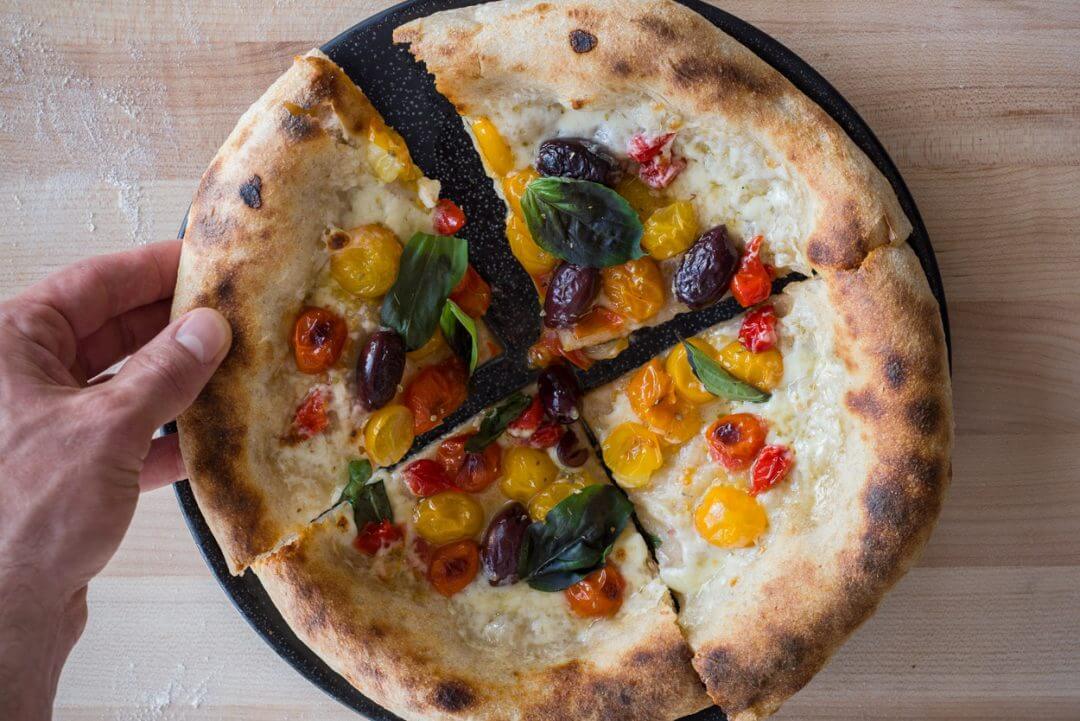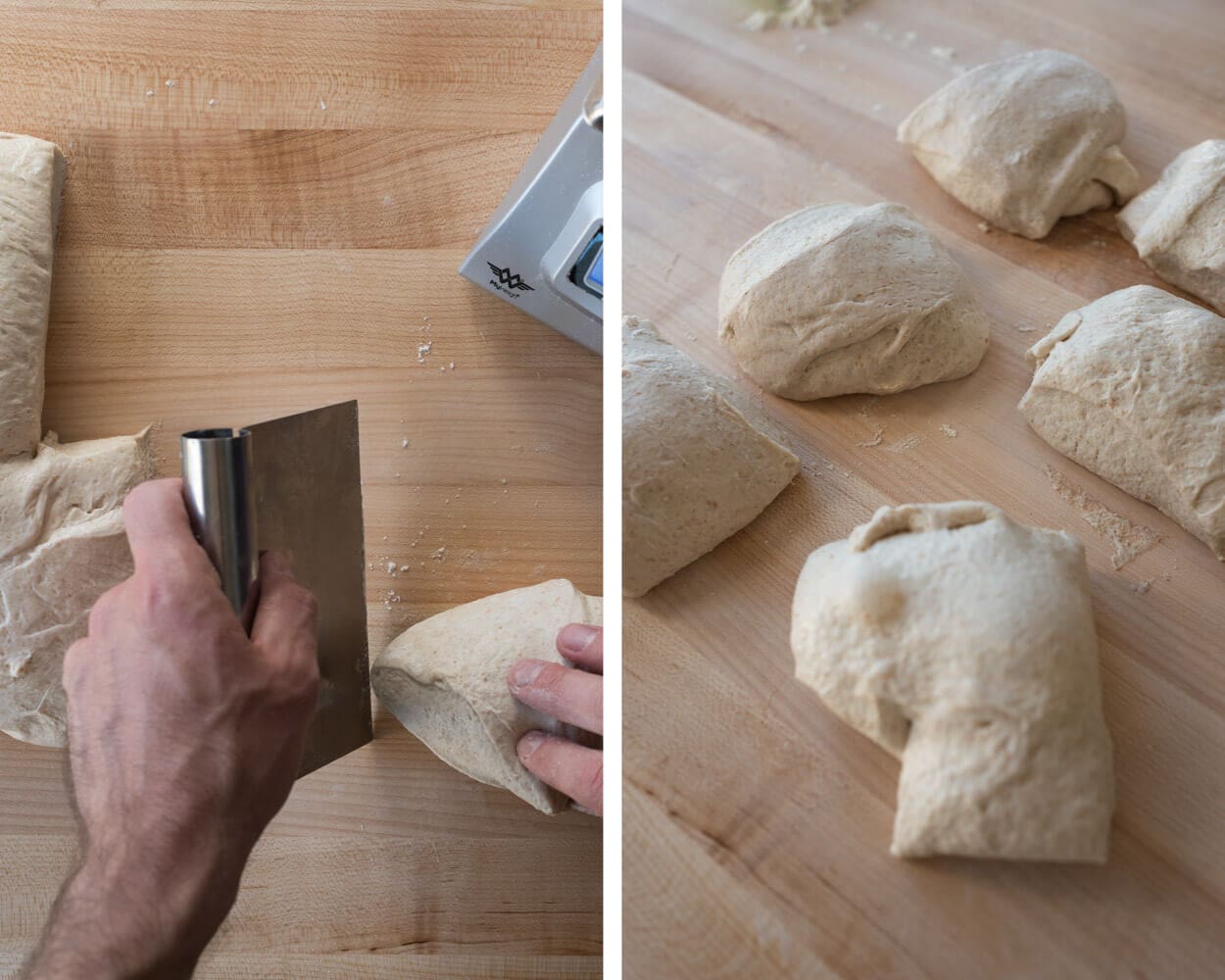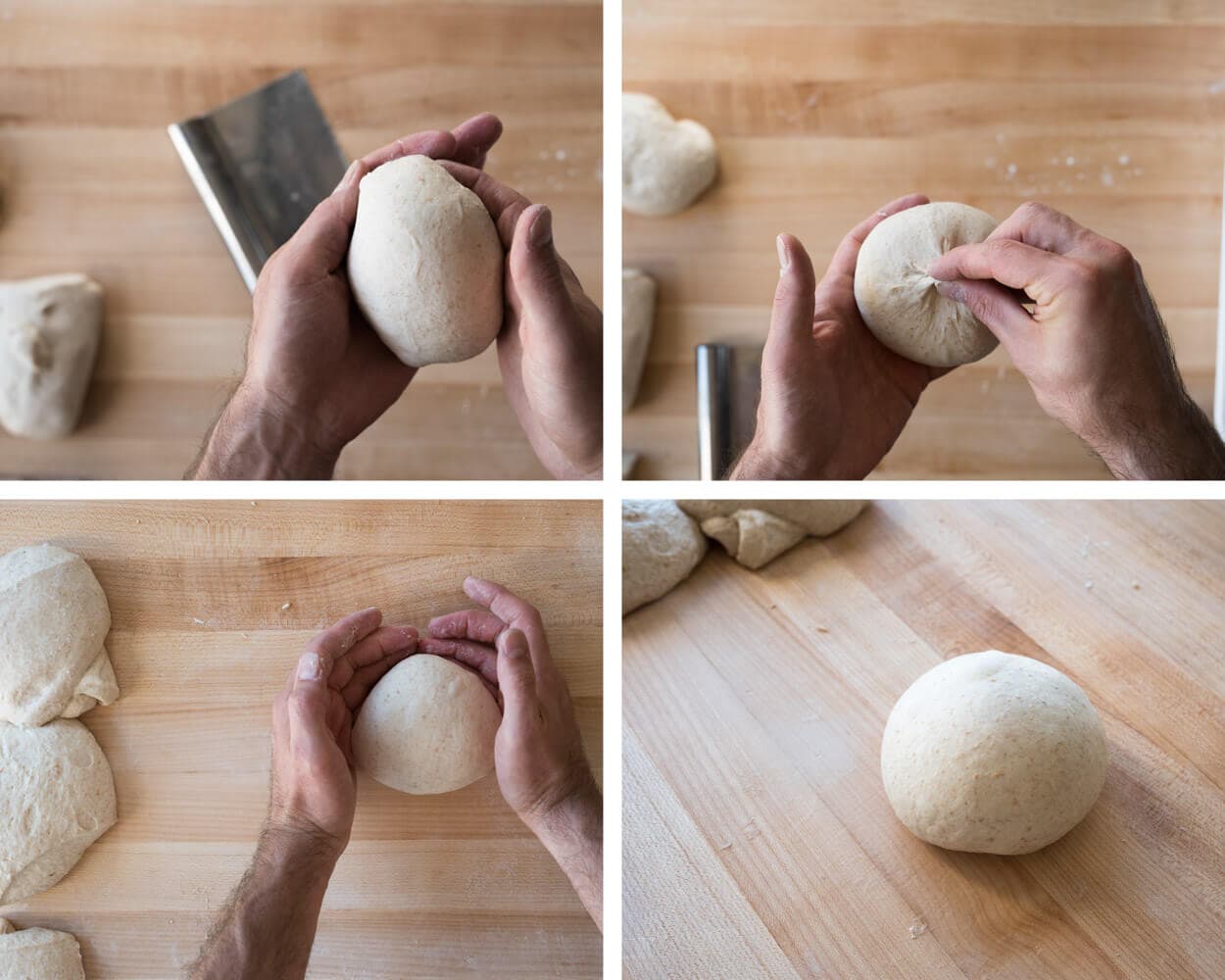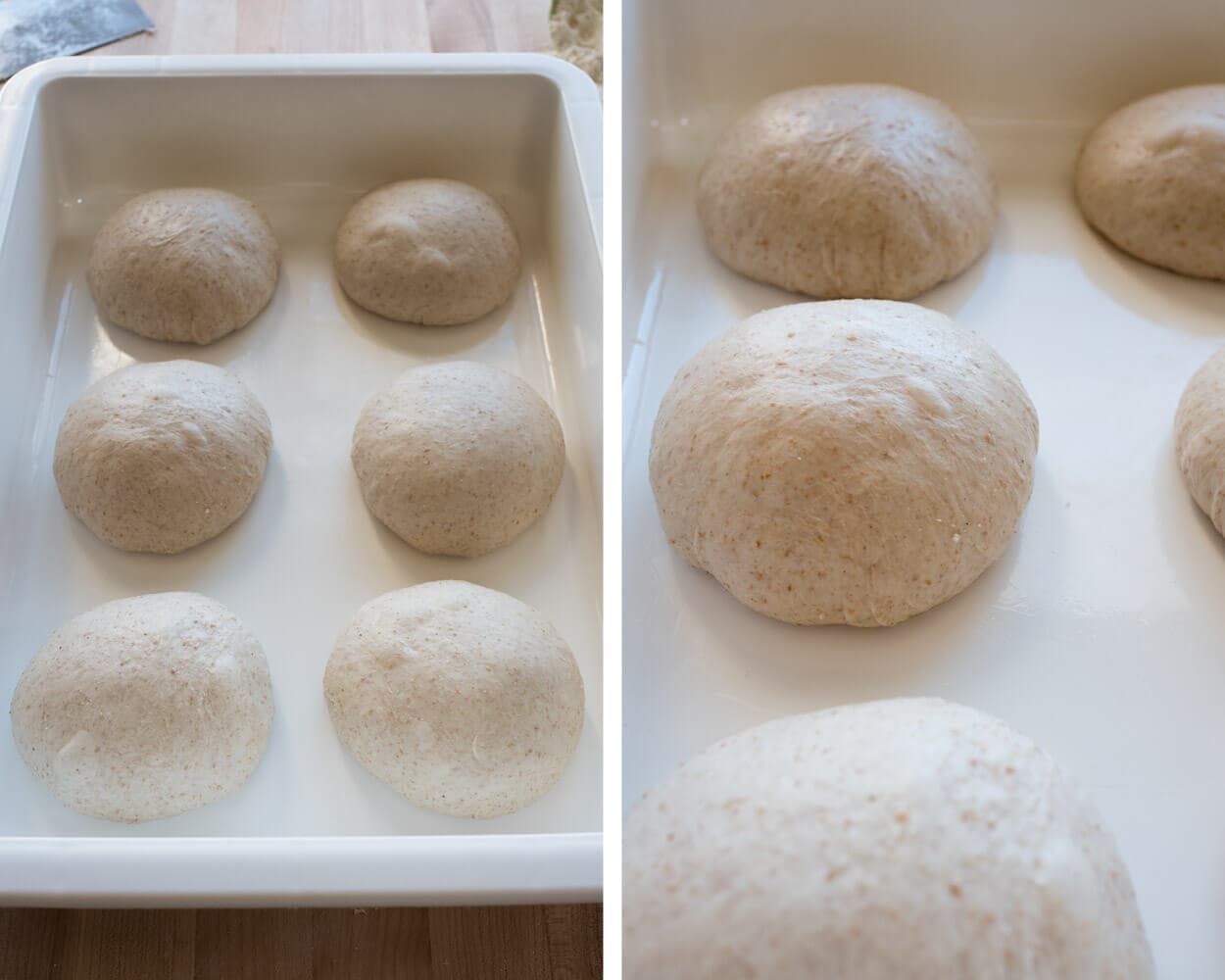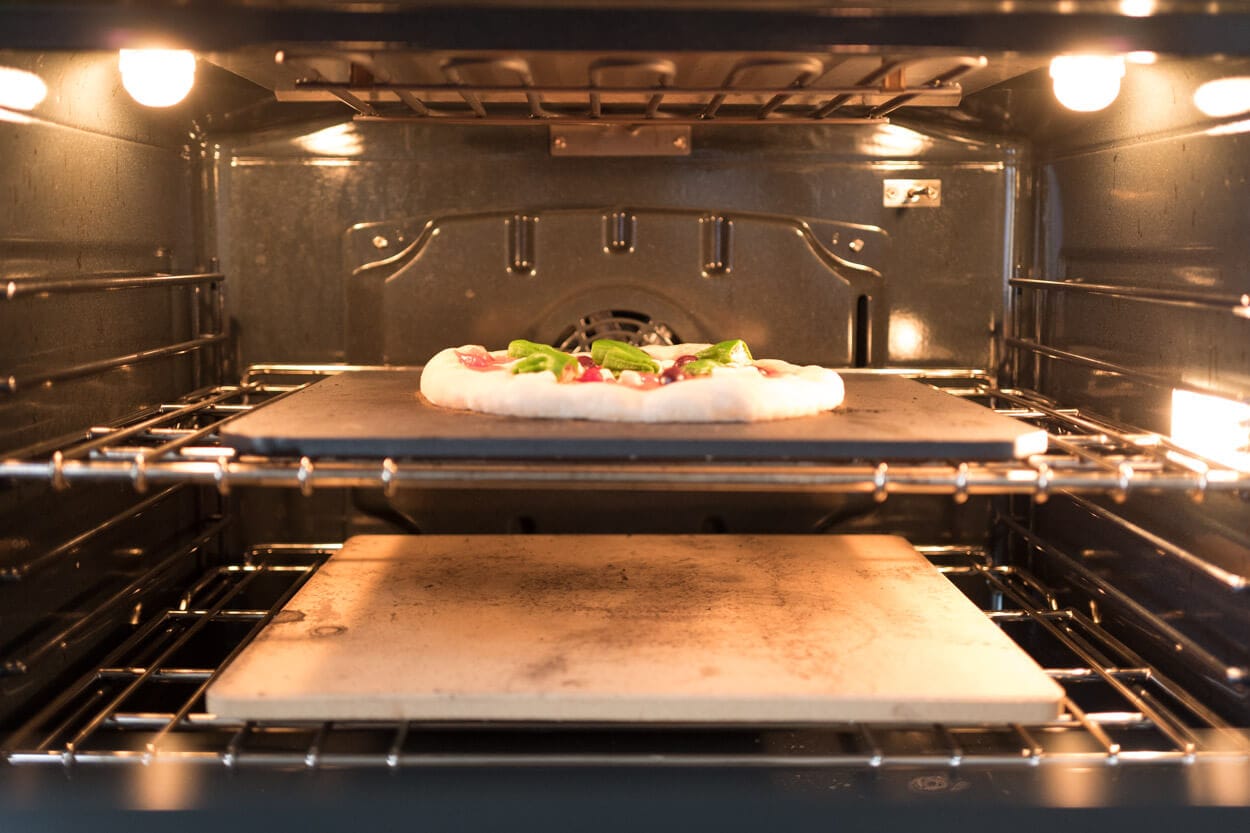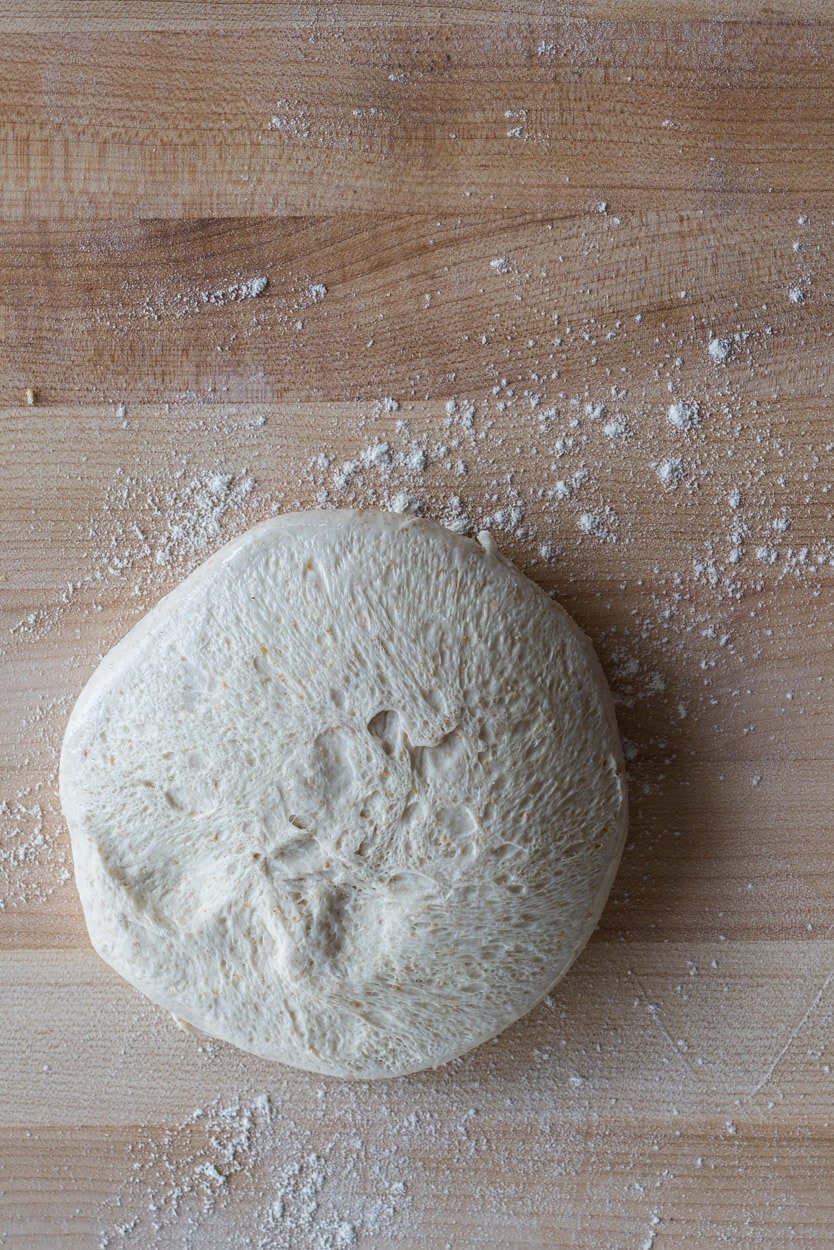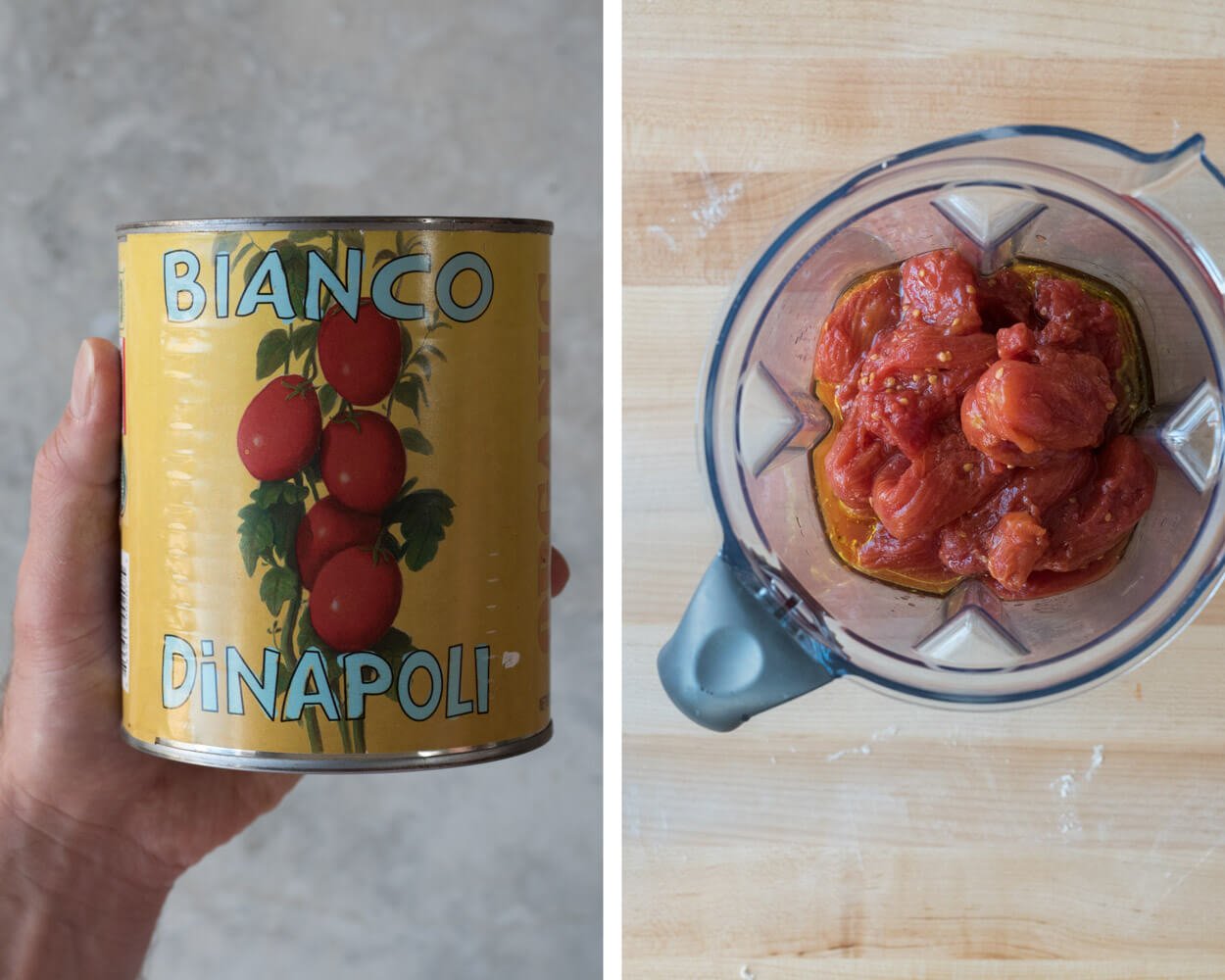I’m a serious pizza eater. There were periods back when I lived near my dad’s restaurant where I’d eat fresh pizza almost every other day. On my way home from work, I’d stop in for a slice (or a whole pie) to sort out dinner. This detour was not because I was lazy and didn’t cook but because it’s hard to deny the call of a great pizza.
I’ve had endless different topping combinations but always fall back on classics: sometimes, I think the simplest things are the best. And pizza is a food I could conceivably eat at every meal without deviation. When visiting a new restaurant, there’s a real internal struggle when I spot pizza on the menu, especially if it’s sourdough pizza dough. My ordering becomes myopic: the entire menu fades away right in front of me, and pizza is all that remains. Even if it’s at some strange fusion restaurant with nothing to do with Italian food, my meal companions can bet I’m going to order pizza. And in the end, I’ll inevitably complain about it right after the first slice. What can I say? I’m picky.

I vividly remember several buddies and I, physically exhausted and running on zero sleep, stumbling into a Peruvian restaurant in the tiny city of Aguas Calientes outside Machu Picchu. We just finished the 4-day hike through the mountains in torrential rain and finally made it to the sacred site.
This was to be our first restaurant meal in days.
As I opened the menu, I spot the typical (delicious) Peruvian fare, but what do you know, they had pizza! Of course, everyone thought I was nuts ordering pizza in the middle of the mountains in Peru. Still, I can’t remember another item on that menu except for the pizza I ordered6. Blinders.
When you think of great pizza, what comes to mind? I think the answer depends on your background, where you grew up, and just how much you’ve eaten. I’ll always have a special place for Naples-style pizza with that thin crust and that blistered and puffy cornicione, but it’s challenging to get this type of crust that comes out of a blazing hot wood-fired oven, and that’s ok.

Pizza at home doesn’t have to try to imitate pizza Napoletana, it can be exciting and delectable in a completely different way. The focus here is to make a sourdough pizza dough that’s incredibly tasty with a fantastic texture but also versatile and flexible when it comes to preparation. Most of us aren’t making pizza professionally, so an adaptable, naturally leavened pizza dough that works around your schedule—and could chill an extended period in the fridge, if necessary—is a good thing.
Great pizza has a thin, sturdy, and well-cooked crust with an airy and soft cornicione (rim). It should sort of sag a bit when you hold a slice in the air but not flop over completely like Neapolitan-style pizza. The bottom should be well cooked with dark spots scattered about, but not the typical leopard spotting you might find when cooking pizza in a high-heat oven. The toppings should be a light dusting of items, especially the cheese—everything in balance.
This sourdough pizza dough is versatile and adaptable. So, if you like a thicker crust, increase each dough ball’s weight, and don’t stretch it out quite so thin. If you like a thin, cracker-like crust, stretch the dough ball out thinner and cook for a few minutes until things firm up. You can even use this dough recipe for pan pizza and focaccia.
If you like a Chicago-style pizza… (gasp), I’m not sure I have any suggestions, but I’m sure you can make it work.
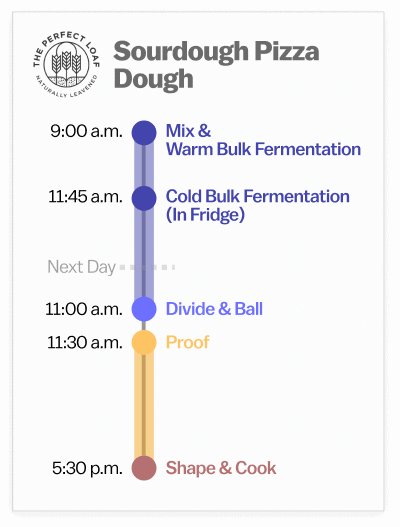
Sourdough Pizza Dough Schedule
You can adjust the schedule for this flexible sourdough pizza dough to suit your schedule. The dough can be made over two days or stretched to three or four days proofing.
Or, you could mix at 5:00 p.m. as I have listed here, and instead of shaping them into balls the next day at 11:00 a.m., you could shape them before work and cook the pizzas right when you get home.
Pizza Flour Selection
I would venture to say that Caputo flour from Italy is probably the most widely used flour for pizza. I’ve purchased a few sacks of Caputo 00 Pizzeria Flour on Amazon to test, and it is nice to work with. They list the protein percentage of their flour (in the blue bag) as between 12-13% (12.75%), but the water absorption is significantly lower than most of the flour I usually work with (meaning it cannot take on super high hydration).
The signifier Tipo 00 indicates it’s milled incredibly fine (it truly feels like light powder). You can’t go wrong with this flour—it performs exceptionally well and makes pizza with a thin, delicate crust that is strong enough to hang onto whatever toppings you throw at it.

However, lately, I’ve been working more with Central Milling Organic Type 00 Normal flour (they also have a “strong” version with a higher protein percentage at around 13.8%), and I’ve come to enjoy this flour. Much like Caputo 00, it is milled incredibly fine, has a very high extraction, and feels powdery smooth. I like that it’s a closer geographic option, and I can order large quantities without too much of a hit to the bank. Using this flour, my pizza has a wonderful crust and a tender interior. Central Milling indicates their flour has around 11.2% protein and is a hard red winter wheat blend.
I know not everyone has a sack of Tipo 00 flour in their pantry; heck, I didn’t until recently. So, feel free to swap these flours out for all-purpose flour (or even a medium-protein bread flour). This sourdough pizza dough will still be naturally leavened, flexible, delicious, and made at home.
The next frontier for me with this sourdough pizza dough recipe will be to explore more fresh-milled grains as a more significant portion of the flour percentage (and I did just that here!). My sourdough pizza formula below is a great place to start, and the 10% whole grains I call for can easily be a springboard for experimentation: swap the whole wheat out for spelt or even Khorasan to play with the texture and taste. I think there’s an equilibrium to find: you don’t want the flavor of the grain to completely overpower the toppings you’re using, but rather to produce a balanced concert of flavors.
To read more about how to adjust the flavor of your pizza, read through my ultimate guide to sourdough pizza →
Why is my sourdough pizza crust chewy?
Using high-protein white flour (13-14% protein) in your sourdough pizza dough can lead to a chewier pizza. If you’d like to reduce the chewiness, try using a lower protein flour for the pizza dough (like all-purpose flour or Type 00 with lower protein).
My Favorite Pizza Tools
I’ve decided to round up all the tools shown here in this post for those wondering what I’m using. I’ve found each of these to be great for their purpose, and I’ve finally collected everything I need to make pizza consistently each week.
- Pizza dough proofing containers – I love these large, rectangular plastic containers that also fit in the home fridge.
- Baking Steel – a highly conductive slab of steel to bake your pies on instead of stone (no cracking, higher temp, etc.)
- Pizza Peel – for sliding the sourdough pizza dough (and bread!) into the oven.
- Pizza Cutter – simple and effective pizza wheel cutter
- Calabrian chili – these are so, so good. Perfect as is or to cook down into an oil for a spicy kick to your sourdough pizza.
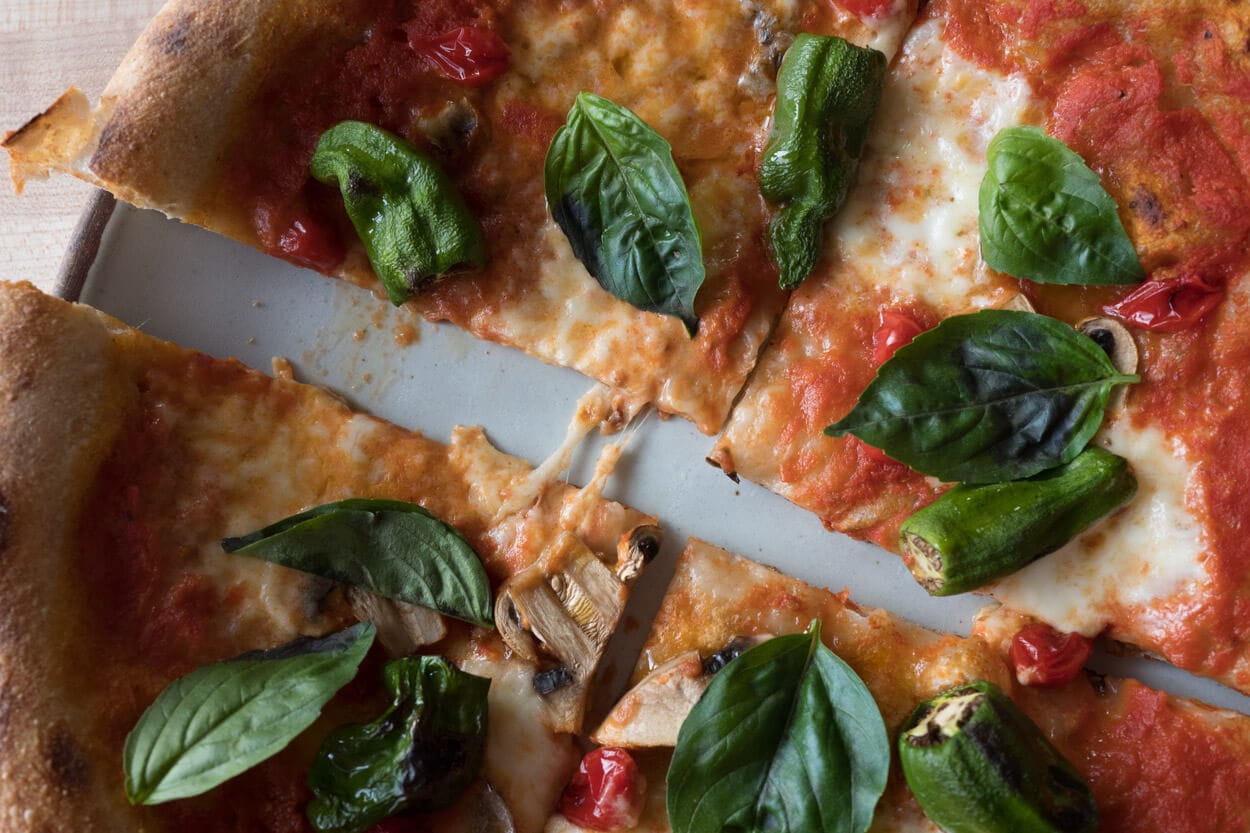
Sourdough Pizza Dough Formula
Why divide the pizza dough into 290g dough balls?
I like to think of pizza and bread as siblings separated in childhood.
In experimenting with varying dough weights for each pizza, I ranged everywhere from a 180g ball to a 300g ball, finally settling on 290g. This is personal, but I found 290g to be the sweet spot for a 12″ personal pizza. If you increase each ball’s weight, you can increase the crust thickness at the bottom or increase the pie’s size. Conversely, you can make a less pronounced rim or smaller pizza if you decrease the weight.
What dough hydration is best for pizza dough?
One of the fantastic things about a super blazing hot wood-fired oven is you can bake a pizza in around 90 seconds. Because it takes longer than that in a home oven, you’ll end up baking off a lot of the moisture in the dough, so your pizza will turn out to be quite firm like a cracker.
By increasing the dough’s hydration, the drying effect can be countered to some degree so the dough can cook longer in the oven. I don’t think 69% is a set-in-stone number. Feel free to go up or down on this depending on how things turn out in the oven, and most importantly: to adjust for your flour.
Additionally, because I advise using parchment paper to launch your pizza into the oven (more below), increasing the hydration into the ’70s is possible (as you increase hydration, it becomes harder and harder to shape and transfer the pizza from your pizza peel to the oven).
Do I need to add diastatic malt powder to this pizza dough?
If you’ve read my site for a while, you’ll know I’m a fan of using diastatic malt powder in some of my recipes to increase enzymatic activity7 and add color to my crust. Adding diastatic malt powder to this pizza dough is optional but recommended.
See the What is Diastatic Malt Powder guide for more information on why it’s useful in baking and pizza.
Vitals and Total Formula
Desired dough temperature: 78°F (25°C) (see my post on the importance of dough temperature).
Note that the numbers add up to a little over 2 x 290g sourdough pizza dough balls (580g versus the listed total dough weight of 592g, above) in the chart below. I add a 2% “buffer” to the formula to ensure the resulting dough provides at least two 290g balls. You might end up with a little excess dough on your bench.
If you want to make more than two sourdough pizza dough balls, just scale everything up using baker’s percentages.
| Weight | Ingredient | Baker’s Percentage |
|---|---|---|
| 288g | Type 00 white flour (Central Milling Type 00 Normal) | 90.0% |
| 32g | Whole wheat flour (Giusto’s Stoneground Whole Wheat) | 10.0% |
| 165g | Water 1 | 51.4% |
| 50g | Water 2 | 15.6% |
| 2g | Diastatic malt powder (optional) | 0.5% |
| 6g | Fine sea salt | 2.0% |
| 48g | Ripe sourdough starter, 100% hydration | 15.0% |
Sourdough Pizza Method
Before we begin, a quick note about building a levain (leaven): I don’t create a specific levain to make this sourdough pizza dough. As I’ve mentioned in my Sourdough Starter Maintenance Routine, a sourdough starter and a levain are essentially the same things. A levain is built as an off-shoot, or splinter, that eventually dies off in the oven with the bread or pizza. With this pizza dough, there is such a small levain requirement there really isn’t a need to make a levain and wait for it to fully ripen before using.
Essentially, you’re using your sourdough starter discard to make this sourdough pizza.
1. Mix – 9:00 a.m.
The goal for mixing this sourdough pizza dough is to develop quite a bit of strength up front. This way, we perform fewer stretches and folds during bulk fermentation.
You can use a mixer to strengthen this pizza dough, such as a KitchenAid stand mixer, or you can do things by hand. I’ve mixed both ways to equal effect. In either case, the result will be a dough that’s not completely smooth but has a very strong feeling. Perhaps a little past medium development.
Mixer
To the mixing bowl of a stand mixer fitted with the dough hook attachment, add the water 1, ripe sourdough starter, flour, salt, and malt. Turn on speed 1 and mix for a few minutes until everything comes together. Once the dough is cohesive, dribble in the remaining water 2 over a minute or two while mixing, waiting to add more water until the previous liquid is absorbed. (If you add the water all at once, the dough will slide around and around.) Then, mix for 4 to 5 minutes until the dough starts to cling to the dough hook and begin to smooth, but it will still be far from fully developed (see image below).
By Hand
To mix this sourdough pizza dough by hand, follow the same procedure as sourdough bread. To a large mixing bowl, add the water 1, water 2, ripe sourdough starter, flour, salt, and malt, and mix by hand until incorporated. Once incorporated, dump out onto your counter and slap and fold the dough for about 5-7 minutes until it firms, smoothes, and holds shape on the counter.
If you don’t want to do slap and fold, you can also perform turns in the bowl, stretching the dough up and folding it over for several minutes until it is strong and resists stretching and folding.
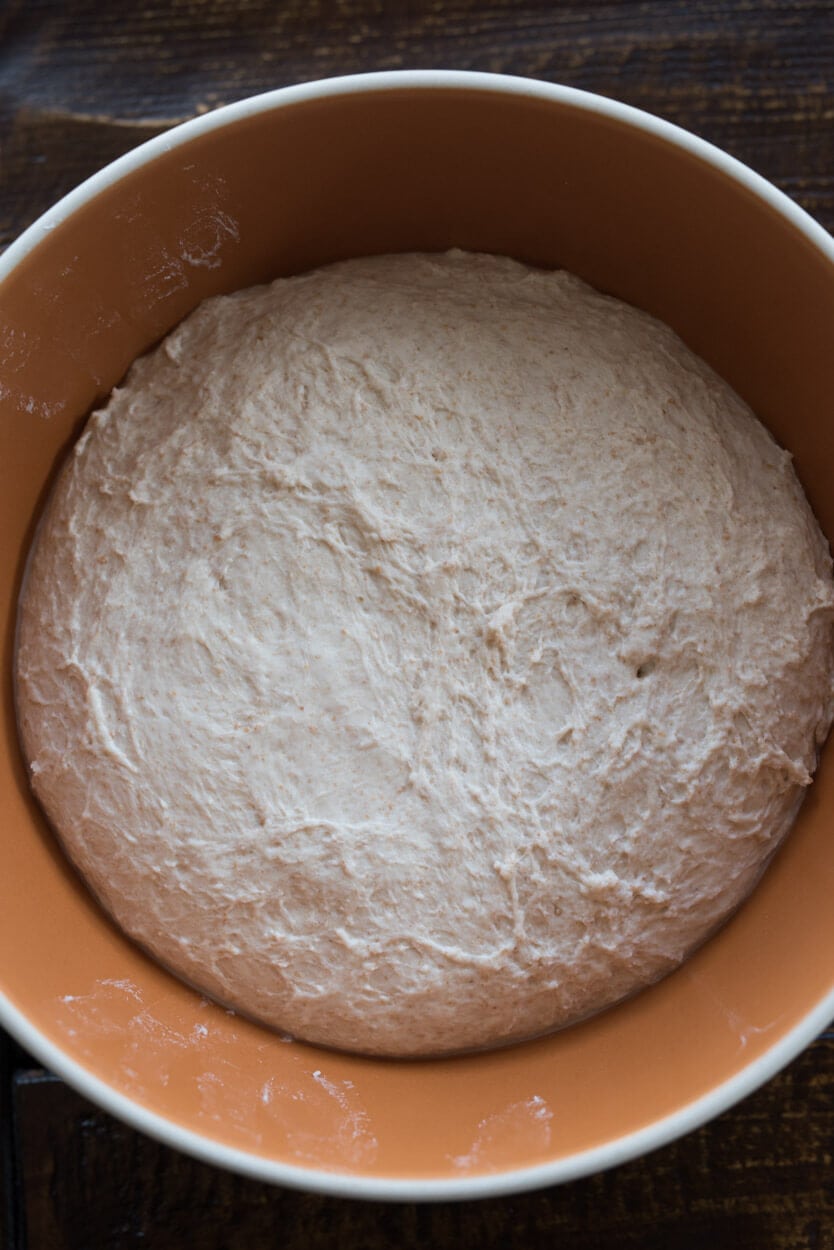
The dough should have smoothed but still shaggy at the mixing end. The low hydration of this dough means it will be hard to mix further at this point without letting it relax. Transfer dough to a thick-walled container (I use a large ceramic bowl) for bulk fermentation on the counter.
2. Warm bulk fermentation – 9:15 a.m. to 11:45 a.m.
At 75-77°F (23-25°C) ambient temperature, bulk fermentation should go for about 2 and 1/2 hours. Perform 3 to 4 sets of stretch and folds—a North, South, East, and West fold for each set – spaced out by 30 minutes during the bulk.
After the third set, check how the dough feels: is it incredibly stiff and resists any stretching? If so, let it rest for the remainder of the 2.5 hours. Give it the final fourth set if the dough is still extensible and slack.
3. Cold bulk fermentation – 11:45 a.m. to 11:00 a.m., overnight)
After 2 and 1/2 hours in bulk fermentation, use olive oil and lightly oil a bowl large enough to hold the dough. Then, dump the dough onto the counter and, using two hands, shape the dough into a very tight boule. You can spin the dough on the counter to create tension on the outside or drag it toward your body while using your pinkies to pinch the dough under itself (like how I shape a boule).
Getting the dough nice and taut is important; don’t worry about degassing.
Wrap the bowl with reusable plastic wrap and place it in the refrigerator overnight.
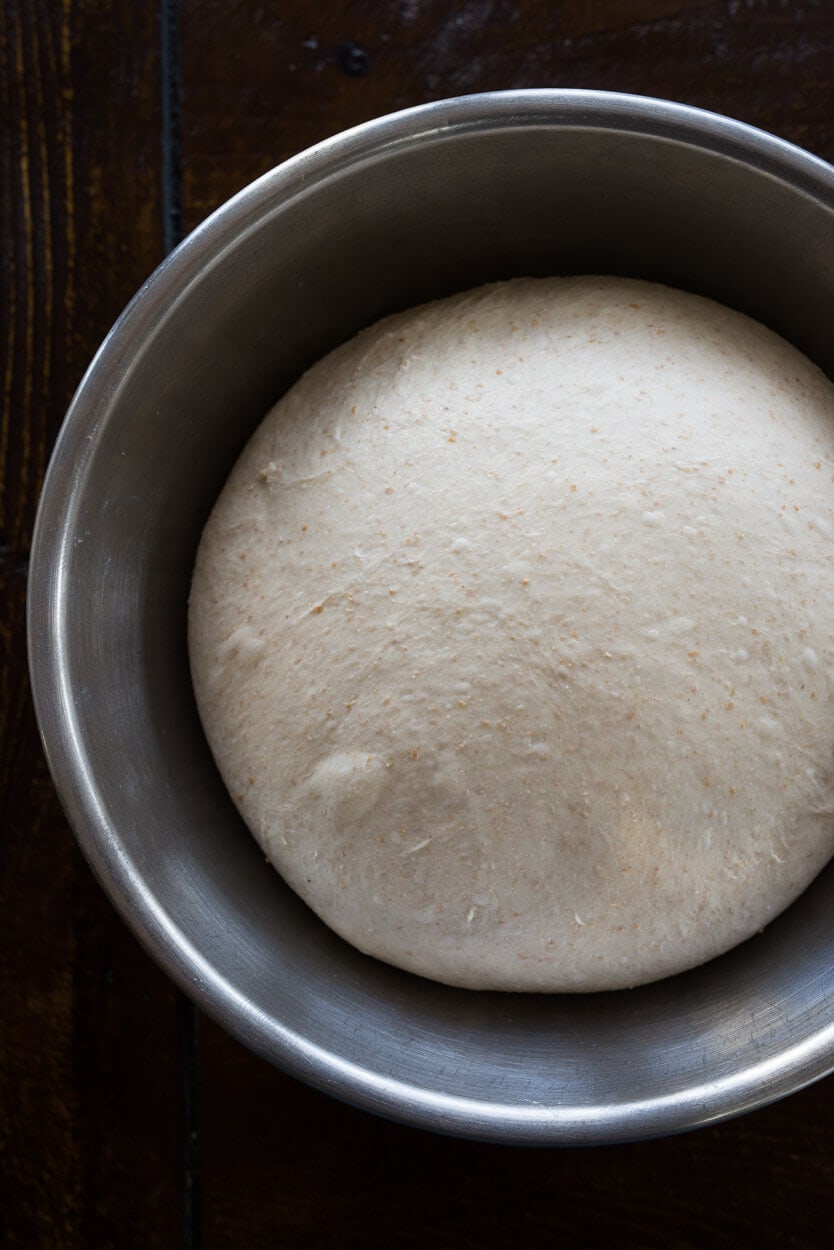
4. Divide and shape sourdough pizza dough balls – 11:00 a.m.
Pick a container to hold your shaped dough balls. With only two, you can use a small baking sheet (like a quarter sheet), or, even better, a high-walled baking dish. I like to use large containers specifically designed to proof pizza dough.
Regardless of the container, lightly oil it with olive oil to make it nonstick.
Remove the bulk container with the dough from the refrigerator and scrape it out onto your un-floured work surface.
Divide the dough into two 290g dough balls and, using almost no flour, form each into a very tight ball. It’s incredibly important to create a ball with a completely closed bottom with no seam. You want a tight skin on each of these surrounding the dough ball.
There are a few ways to do this, but my favorite way is to pick up the ball and, using both hands, tuck the dough back and into itself as you rotate it around in your hand (see the upper-left image above). Work your way around and around, stretching and tucking, then flip the ball over and pinch the bottom to close the seam.
Then place it onto the bench and lightly tug it towards my body one or two times to ensure things are sealed and perfectly round.
Here’s a video of me shaping these sourdough pizza dough balls:
The ball should be smooth all over and on the bottom—try not to have creases, seams, or holes. Transfer to your lightly oiled proofing container.
See my guide to balling pizza dough for a longer walkthrough →
5. Proof – 11:30 a.m. to 5:30 p.m.
Once the balls are shaped and placed into the proofing container, cover them with an airtight lid or plastic wrap. The balls will proof on the counter, around 75°F (23°C), for about 6 hours. At the end of this period, the dough should be puffy to the touch and should have relaxed out from its tight ball into more of a disc shape (see below).
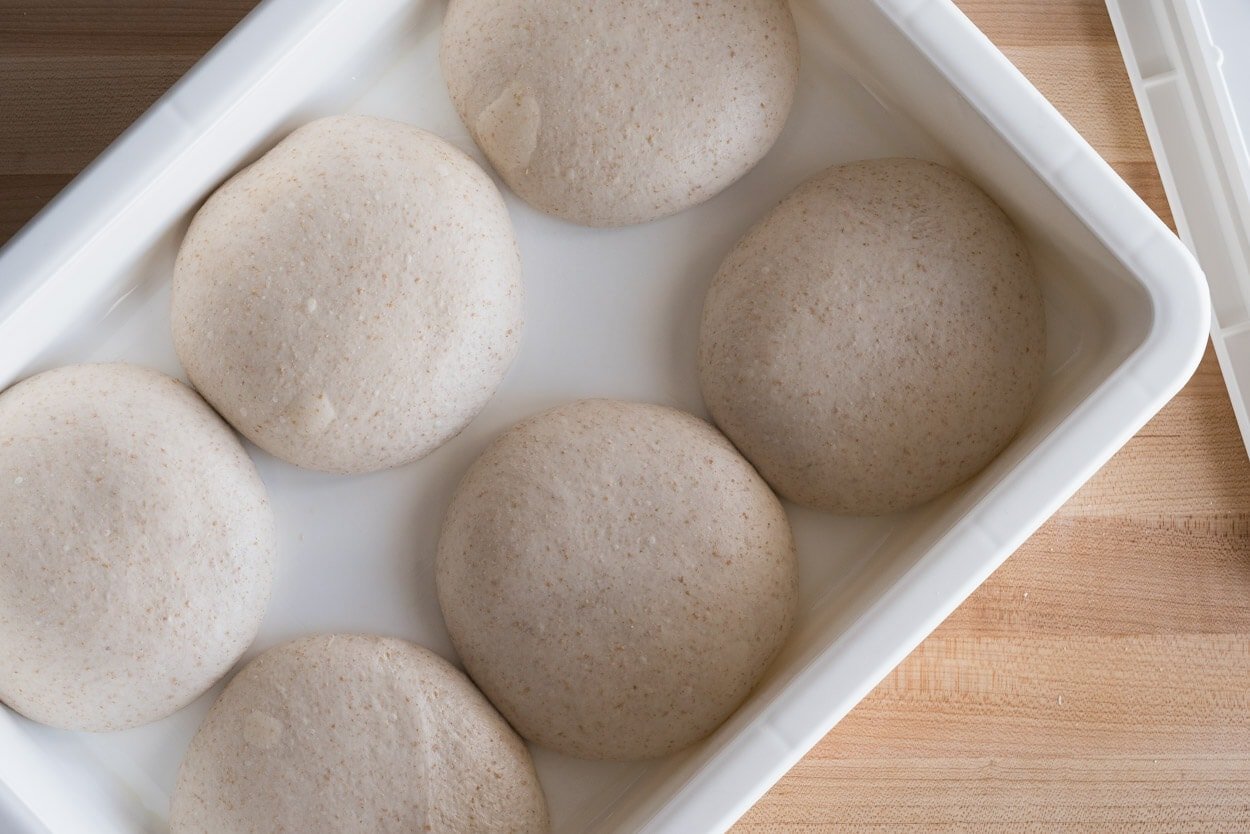
If you’d like to use the dough immediately, start preheating your oven. Alternatively, when the dough is finished proofing, you can place it into the refrigerator, which will hold for several hours, even overnight.
6. Preheat oven at 4:30 p.m., shape and cook at 5:30 p.m.
Preheat the oven on Bake setting for one hour at 550°F (285°C) (or the highest your oven will go). Gather your handheld water mister and place it by your oven; you will use this to lightly spritz the pizza once you’ve placed it into the oven (more on this below).
While your oven is preheating, gather your pizza toppings. Make the pomodoro sauce (see recipe below), and cut the mozzarella into cubes 10.
SHAPING TIP: If you find the dough hard to shape, place the proofing container with dough into the refrigerator to chill slightly for about 15 to 30 minutes. Shaping slightly chilled pizza dough is much easier.
I use a Baking Steel in my oven to bake my pizza, and, as I mentioned before, it does one heck of a job of staying super hot and transferring massive heat to the sourdough pizza dough.
You can see above how I setup my home oven to make pizza.
I place a Baking Steel a few rungs down from the top broiler element. Note that the bottom pizza stone is unnecessary; I keep it in my oven and never move it to save some extra masonry mass for heat retention.
In early pizza trials, I placed the Baking Steel as close as possible to the top broiler with the thought that when I turned that broiler on to superheat the steel, it would get insanely hot—and it sure did. However, that residual heat from the boiler sticks around, so when you launch your pizza on the steel, it cooks the top of the pizza a bit too fast.
I found this extra top-heat to harden off the crust prematurely, stunting dough spring. As you can see, I like it a little lower, just low enough to still get significant heat from the broiler when it’s kicked on but not too close to overdoing the top of the pizza.
Here’s a video of how I like to stretch pizza dough:
Cut a piece of parchment paper to fit your pizza peel and place it on top. Lightly flour your bench and the top of a single sourdough pizza dough ball from the fridge. Using a dough scraper, gently remove the dough ball from the proofing vessel and place the top-side down on your bench (place the remaining ball back into the fridge).
Flour your hands and the side of the ball facing up and begin shaping. Using two hands shaped like an inverted letter “V,” press down the dough uniformly, starting at the side of the dough farthest from you, working toward your body. You want to keep your hands flat with the dough. Try not to press out any gas at the rim of the dough where the edge will form—you want this to rise as high as possible.
While pressing, turning the disc from time to time is easy, and press from top to bottom in different orientations. You’ll feel yourself slightly pressing the gasses from the dough’s interior out to the edges as the center flattens and the border becomes more and more pronounced. If you find the dough sticks too much to your hands and the bench, use more flour, but I find this rarely to be the case. The dough’s cold retard just before shaping helps strengthen the dough, and the light dusting of flour takes care of any residual stickiness.
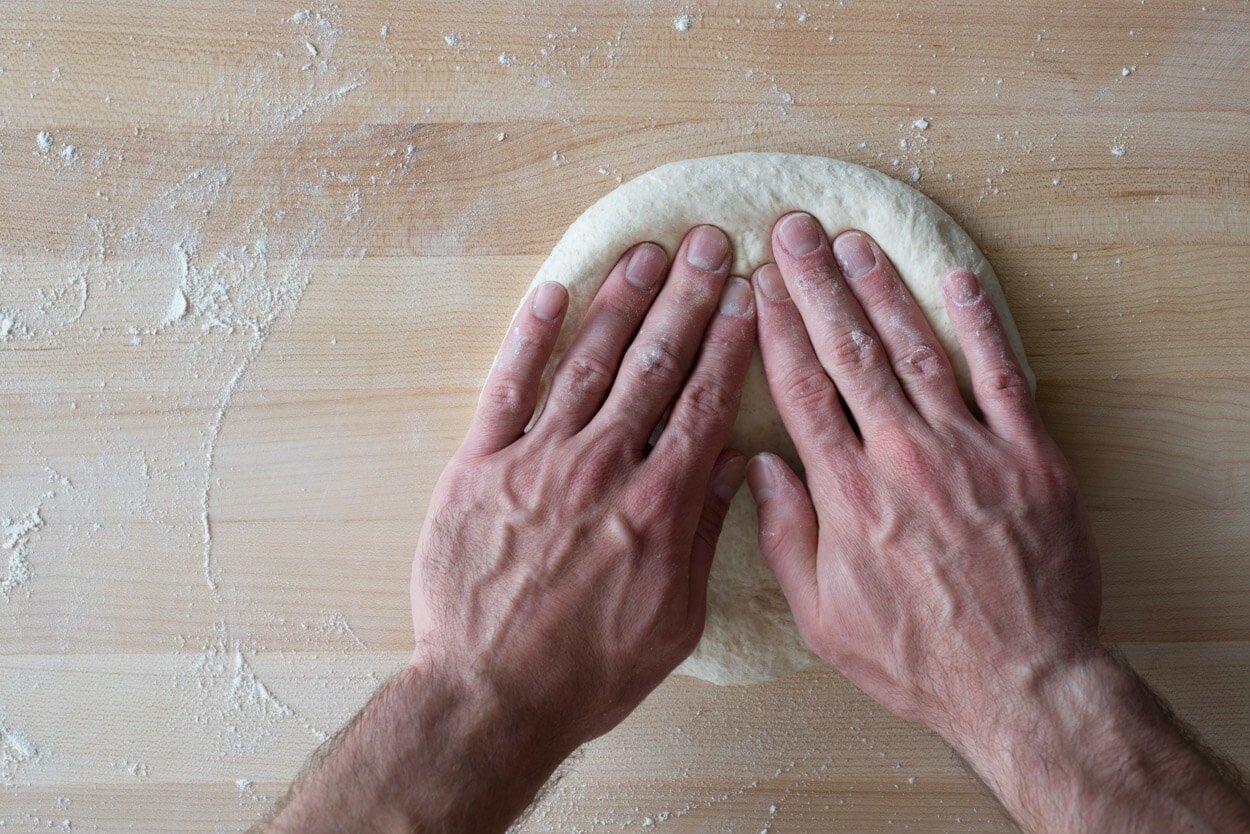
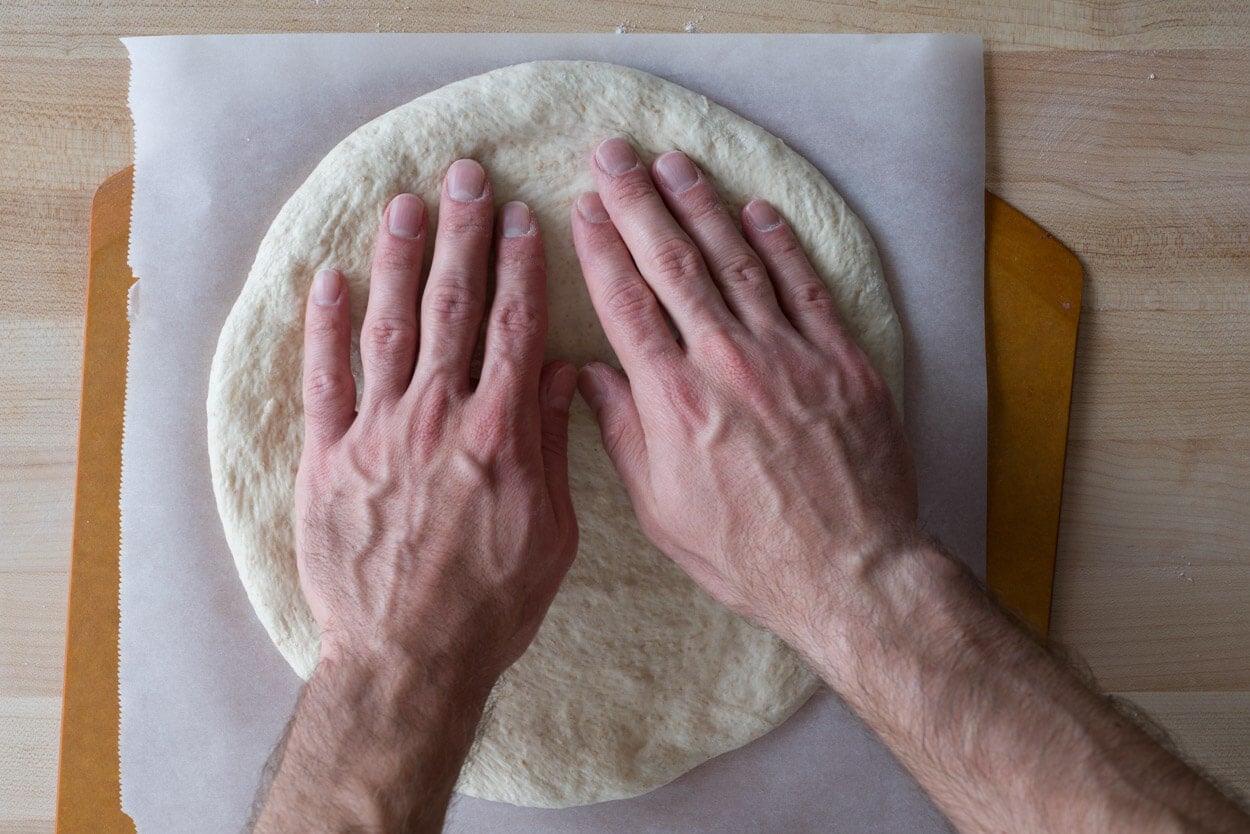
Once pressed out several times, you have a choice: you can transfer the disc to the parchment paper on the pizza peel and finish stretching the dough out on the parchment if that’s more comfortable, or you can lift the disc off the bench and using the back of your hands stretch the dough out as you work around (imagine an Irish-style boxer with their fists up, knuckles pointing away from the body with the dough draped over them).
Another method would be the Naples style “slap,” where you hold the disc on the bench with one hand, stretch the dough outwards with the other, and then lift the disc and rotate it to work around the entire dough. Each method takes some practice, and if you’re starting, shaping on parchment paper is a great way to get a feel for the process while still making it easy to slide the dough into the oven.
Once your dough is on the parchment paper and shaped, switch your oven from Bake to Broil (high). This will engage the broiler, usually taking a minute or two, while you top your pizza. When you have the dough on the parchment, you can relax and focus on working your oven and topping your pizza.
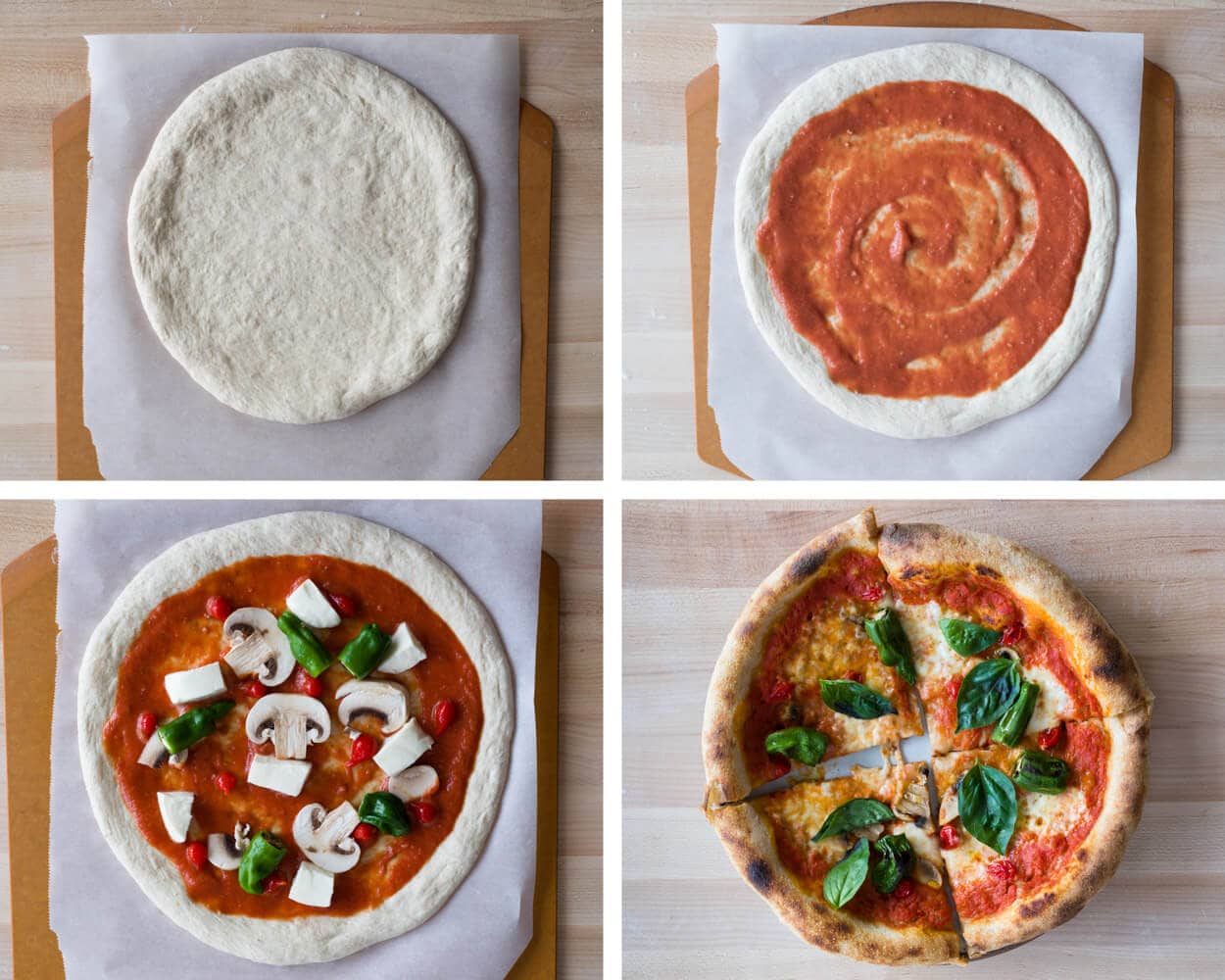
If using my tomato sauce recipe listed below, grab a ladle and scoop out a medium amount of tomato sauce. Pour onto the dough and spread out circularly using the back of the spoon. Top with the remaining items called for in the recipe.
If using parchment paper, slide it into your oven and cook the pizza on the parchment once the dough is topped.
OPTIONAL: Quickly grab your handheld water mister and carefully spray in your oven to slightly wet the dough. I’ve played with misting and not misting. I find it helps give the dough a little moisture (which, if you recall, is a problem with a home oven: we lose moisture before the pizza is cooked, drying out the crust) at the beginning to rise high and prevent overly drying out the crust. If you do not want to use a handheld mister, by all means, skip this step.
The broiler should still be active at this point, and your dough will get an initial blast of the bottom and top heat. Bake with the broiler on for 1.5-2 minutes until you see the dough slightly color, then switch your oven from Broil back to Bake (at maximum temperature). Bake for an additional minute, then using your pizza peel, carefully rotate your pizza 180º in the oven to even out the baking.
Continue baking until done to your liking. I like to underbake these ever-so-slightly, so they are still very soft. Remove from the oven using your pizza peel and transfer to a plate. Top with remaining items (basil, a little more olive oil, etc.), cut, and serve. Repeat for remaining dough balls.
Here is my overall sourdough pizza dough cooking process:
- Take a 290g dough ball out of the fridge and shape out into a disc on parchment paper
- Turn oven from Bake setting (hopefully at 550°F (285°C)) to maximum Broiler setting
- Top dough disc with toppings
- Open the oven and slide in the pizza dough on top of the parchment paper
- Quickly spritz all sides of dough with a handheld water mister and then close the oven door
- Bake for 1.5 to 2 minutes (broiler should be on)
- Turn broiler off and set oven back to Bake at 550°F (285°C)
- After 1 minute, rotate the dough 180° using a pizza peel and carefully grabbing the corner of the parchment paper
- Bake for an additional 4-5 minutes or until done to your liking
Sourdough Pizza Recipes
Below are a few suggestions for pizzas I make often. I like to top my pizza lightly, using only small amounts cheese and sauce. You’ll see in the recipes below and my images throughout—it’s just my preference.
If you like a full pizza, by all means, pack it on. And, of course, feel free to modify these to your heart’s content—use whatever is fresh, local, and in season.
If you have special dietary restrictions, many modifications can be made. For example, my wife cannot eat (most) dairy, so I’ll always sub out the mozzarella for mozzarella di bufala (lactose-free) or goat cheese with a light shaving of aged parmesan.
Basic pomodoro (tomato) pizza sauce
This is my go-to tomato sauce for just about any pizza.
- One 28oz. can whole peeled tomatoes (Bianco DiNapoli or San Marzano)
- 1.5 Tbsp extra virgin olive oil
- 1/2 tsp salt
- 1/4 tsp dried oregano
Drain the whole peeled tomatoes reserving the liquid for another use (like pasta, see below). Place tomatoes, olive oil, salt, and oregano in a blender and blend until desired consistency (I like it very smooth). Taste the sauce and adjust the seasoning if necessary. It will last about a week in the fridge.
LEFTOVER SAUCE TIP: To make a simple and delicious weeknight pasta sauce recombine the leftover sauce with the reserved tomato liquid and cook with kalamata olives and sliced garlic on the stove until reduced significantly (it should sort of coat the back of a spoon), about 30-40 minutes. Top pasta with basil/parsley, freshly grated Parmigiano-Reggiano, and extra virgin olive oil.
Sourdough pizza with pomodoro, mushrooms, peppadew, and padrón peppers

I accidentally discovered peppadew at the market one week, and I can’t get enough of these sweet and tangy little peppers. They’re my secret weapon. They are fantastic on pizza (when used sparingly) as they give an unexpected, but not overpowering, a burst of sweetness that pairs incredibly well with this pizza’s savory and salty flavors.
- One 290g ball Sourdough Pizza Dough
- 1/3 cup Basic Pomodoro Sauce
- 35g mozzarella cut into cubes or torn by hand
- Several padrón peppers with stems removed
- Handful peppadew “sweet drop” peppers
- 2-3 medium-sized white mushrooms
- A handful of kalamata olives (optional)
- Several basil leaves
- Drizzle olive oil
Spread the pomodoro sauce evenly around the pizza in a circular fashion while keeping a 1” border clean around the dough’s outer edge (this will be the crust). Then place the padrón peppers, peppadew, mushrooms, and olives in an even distribution over the pomodoro sauce. Slide the pizza into the oven and cook.
When the pizza is finished cooking, scatter the basil on top with a drizzle of olive oil.
Sourdough pizza with spinach, feta, and garlic confit
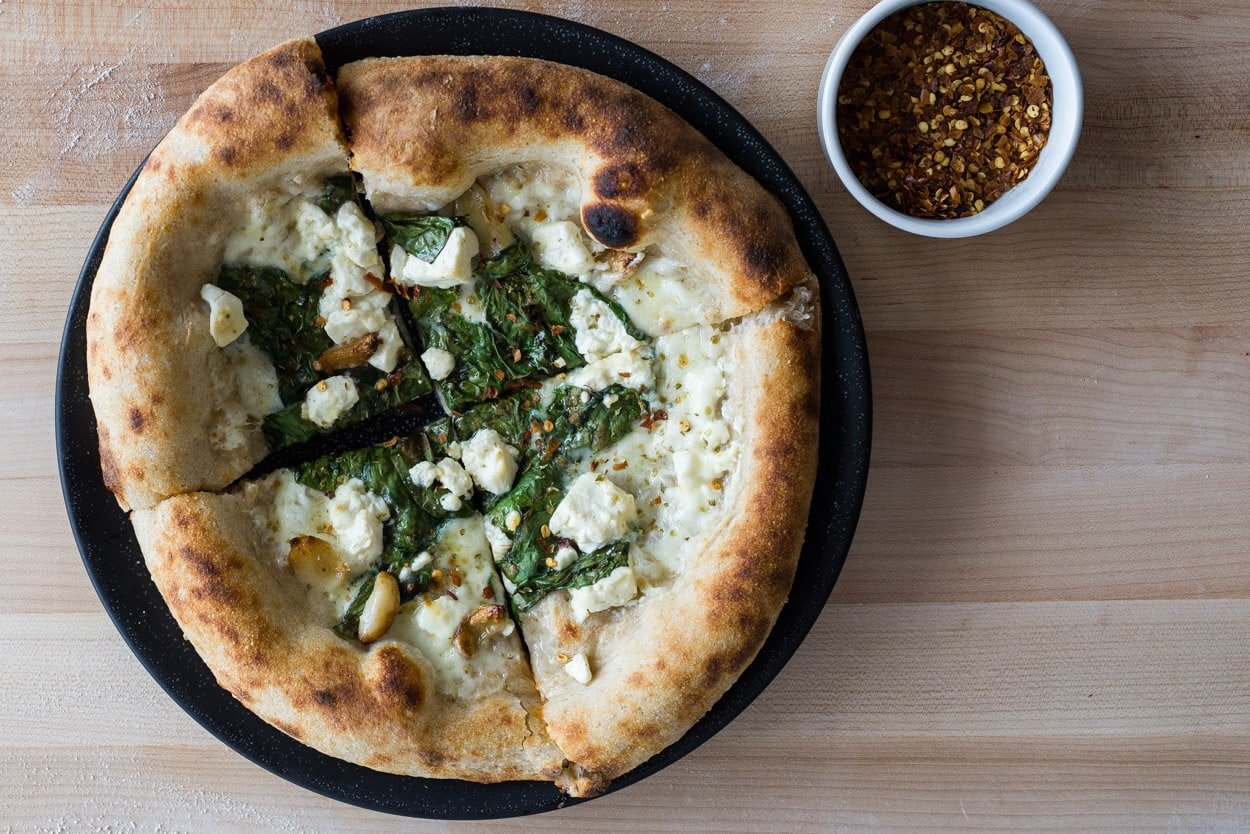
I based this recipe on a pizza from the Gjelina cookbook (one of my all-time favorite cookbooks), and it has just the right balance of flavors. There’s no tomato here, so it’s a good break if you are tomato-ed out. I like to add a pinch of red chile flakes to this one after I finish cooking the pizza.
- One 290g ball Sourdough Pizza Dough
- 2-3 cloves garlic confit (roasted garlic will work also), chopped
- 2 cups whole spinach leaves
- 35g feta cheese
- 35g mozzarella cheese cut into cubes
- Pinch red chile flakes (optional)
- Pinch of dried oregano
- A drizzle of olive oil
Scatter the chopped garlic over the dough and then pile the spinach leaves mainly in the center but a few, reaching out to the crust here and there. On top of, and occasionally below, the spinach, scatter the mozzarella and feta cheese (try not to break the feta into tiny pieces) throughout. Drizzle olive oil lightly on top and cook as described above.
When this pizza is cooked, the cheese will melt on top of and below the spinach, which is just delicious.
Sourdough pizza with pomodoro crudo, mozzarella, basil, and oregano

I love this pizza. I’ve had a variation of this in Italy, and each time I see it on the menu, it’s my first choice. This pizza’s flavor is lighter than one with a traditional tomato sauce, and I think this is what I like so much about it. The taste of oregano, olive oil, and slightly roasted cherry tomatoes is pretty out of this world.
- One 290g ball Sourdough Pizza Dough
- 35g mozzarella cheese cut into cubes
- 2 handfuls of multicolored cherry tomatoes, cut in half
- Scattered kalamata olives (optional but tasty)
- Dried oregano
- Several fresh basil leaves
- Drizzle olive oil
Scatter the mozzarella cheese on the dough while leaving a 1-inch border from the edge clean. Starting at the dough center, place cherry tomatoes cut side down, radiating outwards randomly (these look awesome mixed and matched with the highest density in the middle). Drizzle a few “circles” of olive oil around and slide the dough into the oven to cook.
When finished, sprinkle the dried oregano and place the basil leaves on top. This pizza would also be awesome with a pinch of red chile flakes or Calabrian chile oil.
Conclusion
Nowadays, I find myself heading to my dad’s restaurant a little less frequently, but at least when I can’t make it out during the week, I can get some pretty darn good pizza at home with my sourdough starter and this sourdough pizza dough recipe.
Also, who says it’s bad to have homemade sourdough pizza at home during the week and then head to the restaurant for more pizza on the weekend? I love that idea.
Whew, that was a hefty post! Lots of process photos, pizza photos, and comments on how I’ve been honing my sourdough pizza dough-making skills at home. I hope you do not feel overwhelmed by the length of this post but rather come away feeling like you have a single place to go back to for all the tiny details that sometimes get lost with making pizza at home.
Print
Sourdough Pizza Dough
- Author: Maurizio Leo
- Prep Time: 24 hours
- Cook Time: 10 minutes
- Total Time: 24 hours 10 minutes
- Yield: 2 pizzas
- Category: Pizza, Sourdough
- Cuisine: Italian
Description
A versatile sourdough pizza dough recipe for the home oven.
Ingredients
- 288g Type 00 white flour (or all-purpose flour)
- 32g whole wheat flour
- 215g water
- 2g diastatic malt (optional)
- 6g salt
- 48g ripe sourdough starter
Instructions
- Mix – 9:00 am
Add the ingredients to a mixing bowl or stand mixer. Mix until medium development (the dough should be smooth but still shaggy and elastic. Transfer the dough to a bulk fermentation container and cover. - Warm bulk fermentation – 9:15 am to 11:45 am
This dough will need 3 sets of stretch and folds during bulk fermentation at 30-minute intervals. - Cold bulk fermentation – 11:45 am to 11:00 am, overnight
Remove the dough from the bulk fermentation bowl and lightly oil the interior with olive oil. Tighten the dough on the counter into a ball and transfer it back to the oiled bowl, seam side down. Cover the bowl and transfer it to the refrigerator overnight. - Divide and preshape into a ball – 11:00 am
Divide the dough into two 290g pieces. Shape the dough into a very tight ball with no seam on the bottom. Transfer to a pizza dough tray or baking sheet and cover. - Proof – 11:30 am to 5:30 pm
Proof the dough on the counter at around 75°F (23°C) for 5-6 hours. When fully proofed, the dough will have relaxed outward and be soft to the touch. If using the dough soon, preheat your oven. Alternatively, you can place the dough back into the fridge until the next day. - Cook – 5:30 pm
Preheat your oven with Baking Steel, one or two rungs from the top, to 550°F (285°C). Shape a dough piece into a large circle on parchment paper. Switch the oven to Broiler setting, top your pizza dough, and slide the dough onto the Baking Steel. Spritz the inside of the oven a few times with a handheld water sprayer. Bake for 1.5-2 minutes with the broiler on, then turn the oven back to the Bake setting at 550°F (285°C). After 1 minute, rotate the pizza in the oven. Bake for another 4-5 minutes until done to your liking. Repeat for the other piece of dough.
Notes
There is no need to make a levain for this recipe, use your ripe sourdough starter.
What’s Next?
If you’d like a different direction with pizza, have a peek at my rectangular sheet pan pizza recipe; it’s also a winner!
Or, for more sourdough pizza shaping, stretching, and cooking guides, check out my ultimate guide to sourdough pizza.
If you use this recipe, tag @maurizio on Instagram so I can take a look!
For the record, and to their credit, it was certainly not a good pizza. But what should I have expected?↩
The action of breaking down starches into sugars that yeast can utilize for fermentation↩
This hydration takes the water in the 100% hydration starter into account.↩
A little extra added to the recipe to ensure enough dough is made to cover the number of pizzas called for↩
Keep in mind the smaller the blocks of cheese you make, the faster they will bake (and burn); there’s a sweet spot to find↩
For the record, and to their credit, it was certainly not a good pizza. But what should I have expected?↩
The action of breaking down starches into sugars that yeast can utilize for fermentation↩
This hydration takes the water in the 100% hydration starter into account.↩
A little extra added to the recipe to ensure enough dough is made to cover the number of pizzas called for↩
Keep in mind the smaller the blocks of cheese you make, the faster they will bake (and burn); there’s a sweet spot to find↩


